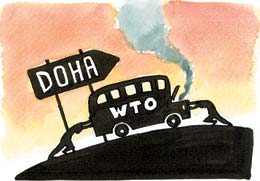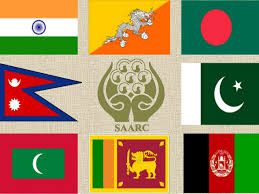Narendra Modi said that Doha round of talks was yet to be implemented and made a case for countering the challenges posted to the multilateral trading system. He emphasised that conflict resolution is a key benefit of the WTO. This WTO meet didn’t seem to prove that as the ‘trade war’ unleashed by the US under its new protectionist laws announced indicate even putting the India-US oil trade in jeopardy. Here’s an analysis by Navodita, our Associate Editor, in the weekly column, exclusively for Different Truths.
The government said Sunday that 50 nations will engage in free and frank discussions on global trade here this week to explore the options for resolving various issues and reinvigorating the WTO. Representatives from 50 countries met to discuss opportunities to engage in free and frank discussions with the hope that it will lead to political guidance on some major issues. It said it would look at issues both at the negotiating table and also in other areas. The meeting was more of an ‘ice-breaker’ as it is being held after the collapse of talks at Buenos Aires WTO Ministerial meet in December.
In the absence of 11th Ministerial Conference that took place from 10 to 13 December 2017, in Argentina, it is hoped that New Delhi meeting will provide an opportunity for ministers to explore in greater detail the options on different issues for reinvigorating the WTO. The Ministry’s statement further said that safeguarding and strengthening the multilateral trading system was never as important as it is today, and the WTO is also facing systemic challenges, particularly its dispute settlement arm. It seems the Asian countries are all gearing up for an economic restructuring of sorts and there has never been a greater need felt for a more self-reliant growth. However, as the meeting got underway, at least four major WTO members- the European Union, Japan, South Korea and Brazil – attacked the US for increasing import duty on steel and aluminium and threatened retaliatory action as Washington’s stand at this multilateral body was under scrutiny.
 The main focus of the discussions in Delhi was to find a way to get negotiators to get back on track on the agenda. While there was an overwhelming support to continue with the Doha round, which focuses on the farm, industrial tariffs and services trade, more than half the members were in favour of expanding the agenda to include talks on putting in place an international regime for investment facilitation and micro, small, and medium enterprises. Meanwhile, the PM Narendra Modi said that Doha round of talks was yet to be implemented and made a case for countering the challenges posted to the multilateral trading system. He emphasised that conflict resolution is a key benefit of the WTO. This WTO meet didn’t seem to prove that as the ‘trade war’ unleashed by the US under its new protectionist laws announced indicate even putting the India-US oil trade in jeopardy.
The main focus of the discussions in Delhi was to find a way to get negotiators to get back on track on the agenda. While there was an overwhelming support to continue with the Doha round, which focuses on the farm, industrial tariffs and services trade, more than half the members were in favour of expanding the agenda to include talks on putting in place an international regime for investment facilitation and micro, small, and medium enterprises. Meanwhile, the PM Narendra Modi said that Doha round of talks was yet to be implemented and made a case for countering the challenges posted to the multilateral trading system. He emphasised that conflict resolution is a key benefit of the WTO. This WTO meet didn’t seem to prove that as the ‘trade war’ unleashed by the US under its new protectionist laws announced indicate even putting the India-US oil trade in jeopardy.
On March 29, when the first American shale gas lands at Dabhol regasification terminal in Maharashtra, the US President’s war cry against trade imbalance will be addressed, at least partly. While the American administration believes that US crude oil imports have the potential to increase bilateral trade by at least $2 billion, for India, this means diversifying source geographies. And this may not be at the cost of its imports from West Asia that currently meets over 60 percent of India’s crude oil demand. Enhanced trade typically improves other aspects of their relationship. America should have a rethink as the crisis of imposition of duties on steel and aluminium is likely to worsen in the days to come.
On the economic front, there have been indications to show the growing strength of the Indian economy. There was a SAARC-CII conclave in Kathmandu where leaders pressed on the economy as the most important agenda despite political challenges and compulsions. Shobana Kamineni, President, CII, said that the SAARC region will continue to grow for another 25 years with 30-35 percent of its population as young with India alone nearly 60 percent of the people under the age of 35 years, so it is imperative that they stay healthy and eligible for jobs. Job-creation remained the main thrust for these nations despite the fact that there were a lot of political agendas to be discussed. There have been indications, however, that  just as Afro-Asia block is rearing its head towards becoming a force to reckon with, ASEAN is also coming forward to take up an important stand against the big western powers.
just as Afro-Asia block is rearing its head towards becoming a force to reckon with, ASEAN is also coming forward to take up an important stand against the big western powers.
The leaders of Australia and Singapore closed a regional summit last weekend with a stand against protectionism, arguing in favour of multi-nation trade deals as fears mount that US plans for new tariffs could stoke a global trade war.
Singapore’s Prime Minister Lee Hsien Loong said that “we strongly believe that a free, open and rules-based multi-trading system is key to the region’s growth and prosperity.” As President Donald Trump had announced tariffs on March 7 to protect domestic steel and aluminium producers on national security grounds and is looking at tariffs on up to $60 billion worth of Chinese imports, targeting technology and telecommunications sectors, Australian PM Malcolm Turnbull and Singapore PM urged ASEAN to speedily agree to the Regional Comprehensive Economic Partnership (RCEP), a China-backed alternative to the Trans-Pacific Partnership trade pact that Trump withdrew the United States from last year. Officially, the summit was focused on fostering closer economic ties among the members of ASEAN and Australia countering the threat of Islamic militants returning to the region from the Middle East. Australia hosted the weekend meetings despite not being a member of the 10-nation bloc aiming to tighten political and trade ties in the region amid China’s rising influence. ASEAN and Australia have called for a ‘self-restraint in the South China Sea’.
As India’s vision turns ‘pan-East’, what stand will it take vis-à-vis the US and the west will determine the future balance of trade with the big western powers. It’s better to tread safely than be sorry later.
©Navodita Pande
Photos from the Internet
#ASEAN #US #IndiaPolitics #WTO #China #Kathmandu #InternationalPolitics #Aamonomics #DifferentTruths







 By
By

 By
By
 By
By